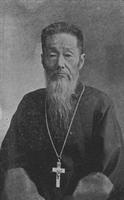 The son of a samurai and son-in-law of a Shinto priest, Takama Sawabe was a fierce Japanese nationalist. He hated Christianity and all foreign influences in his country. One day he angrily confronted the Orthodox Christian missionary to Japan, a Russian priest-monk named Nicholas (Nicolai). Father Nicholas spoke to him:
The son of a samurai and son-in-law of a Shinto priest, Takama Sawabe was a fierce Japanese nationalist. He hated Christianity and all foreign influences in his country. One day he angrily confronted the Orthodox Christian missionary to Japan, a Russian priest-monk named Nicholas (Nicolai). Father Nicholas spoke to him:"Why are you angry at me?" Fr. Nicholas asked Sawabe.
"All you foreigners must die. You have come here to spy on our country and even worse, you are harming Japan with your preaching," answered Sawabe.
"But do you know what I preach?"
"No, I don't," he answered.
"Then how can you judge, much less condemn something you know nothing about? Is it just to defame something you do not know? First listen to me, and then judge. If what you hear is bad, then throw us out."
After listening to Father Nicholas and learning about the Orthodox Christian way of life, the nationalist samurai who had once endorsed Shintoism now believed in Jesus Christ and was baptized, becoming the first person to embrace Orthodox Christianity in Japan. At his baptism, he appropriately received the Christian name Paul, after St. Paul, one of the Church's greatest Apostles who, before his conversion, had used his authority to violently persecute the Christian Church. Paul Sawabe would eventually be ordained an Orthodox Christian priest. You can read about Father Paul (pictured here) in a brief article on the Japanese National Diet Library website dedicated to Portraits of Modern Japanese Historical Figures, which includes another photo, and on Orthodoxwiki.
Father Nicholas, the missionary who taught Paul the Orthodox Christian Faith and baptized him, was later consecrated as bishop and is today known as St. Nicholas of Japan.
According to the the book, Missionaries, Monks, and Martyrs, St. Nicholas worked hard to learn about Japanese language and culture:
Along with language learning, Nicholas studied the culture and history of Japan. He read their mythology and literature, and learned about Confucianism, Shintoism, and Buddhism. He even attended the sermons of popular Buddhist preachers and public storytellers in hopes of understanding the mind of the Japanese. For close to seven years he continued this intense study. Eventually, he became one of the foremost scholars of the Japanese language and went on to translate service and prayer books, catechism books, and the Scripture, as he waited for opportunities of evangelism to open within the country. (111)
Articles on the life of St. Nicholas of Japan are available on the website of Transfiguration of Our Lord Russian Orthodox Church in Baltimore and on Orthodoxwiki. An icon of him can be seen on the Orthodox Church in America website. The Antiochian Orthodox Church in the United Kingdom and Ireland has provided a great article by Fr. Gregory Hallam on the mission strategy of St. Nicholas of Japan, and its relevance for the Orthodox Church today.
You can read about the Orthodox Church in Japan on Orthodoxwiki. The official website of the Orthodox Church in Japan contains photos of Holy Resurrection Cathedral in Tokyo. "The Orthodox Church Singing in Japan" website offers an article by Maria Junko Matsush on St. Nicholas and the music of the Orthodox Church in Japan.
On the same music-themed site you can listen to the Troparion of Pascha (Easter) sung in Greek, Romanian, and Japanese according to the musical tradition of the Orthodox Church. In English, the words of the troparion are "Christ is risen from the dead, trampling down death by death and on those in the tombs bestowing life!"
This post is dedicated to my good friend Nicholas, who grew up in Japan, the land of his ancestors. Several years ago, Nicholas believed in Jesus Christ, renounced both the Buddhism and secularism of his past, and was baptized into the Holy Orthodox Christian Church at Pascha (Easter), when we celebrate the Resurrection of Jesus Christ. At baptism, he received the name of his patron saint, St. Nicholas of Japan, as his own. May God grant him many years!
The photo of Father Paul Sawabe is in the public domain. The above dialogue between Sawabe and St. Nicholas and the cited quotation is from the book, Missionaries, Monks, and Martyrs: Making Disciples of All Nations by Luke Alexander Veronis, (Light and Life Publishing, 1994), 111-112.
